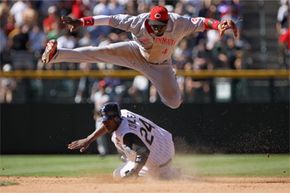In "Bull Durham," the much-beloved movie about baseball, romance and metaphysics, one of the most memorable scenes involves the Durham Bulls manager (played by Trey Wilson) chewing the team out after another loss in an interminable losing streak. After heaving an armful of bats into the shower, the red-faced manager growls, "This is a simple game. You throw the ball, you hit the ball, you catch the ball. You got it?"
On the surface, this quip seems like the perfect encapsulation of America's pastime. But as anyone who's tried to throw a knuckleball, hit a curveball or catch a deep shot to center field will confess, baseball isn't as simple as it might seem. Crash Davis (Kevin Costner), the veteran catcher of the same movie, provides a glimpse of the game's subtle complexities when he tries to teach his hapless, but wildly talented, pitcher another lesson:
Advertisement
Crash is probably closer to the truth. Baseball is a game of numbers, and even though few ball players hold a degree in mathematics, every one is a practiced mathematician on the field. That's because baseball obeys the same physical principles that govern planetary motion, car crashes and airplane flight. Yes, the spirit of Isaac Newton is alive and well on ball diamonds all over the world. And although a home-run hitter or a Gold-Glove-winning third baseman might not think about Newton or be able to recite his three laws of motion, he understands these and other physical principles intuitively.
This article will explore some of those physical principles and attempt to reveal the science behind the intuition. And just to make things interesting, we'll take a cue from the Durham Bulls manager, breaking down the physics of throwing, hitting and catching, in that order. That puts us on the mound, 60.5 feet (18.4 meters) from home plate, to start things off.
Let's throw the first pitch.

